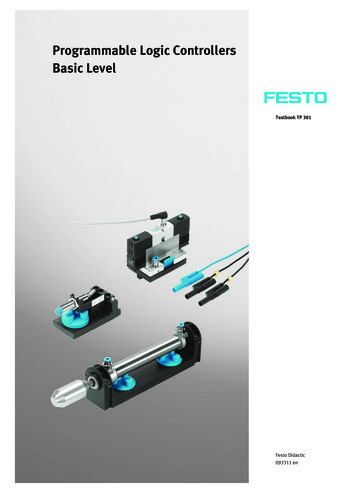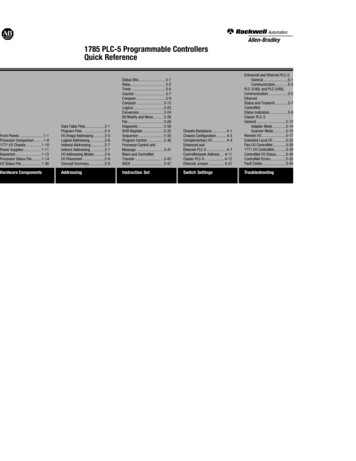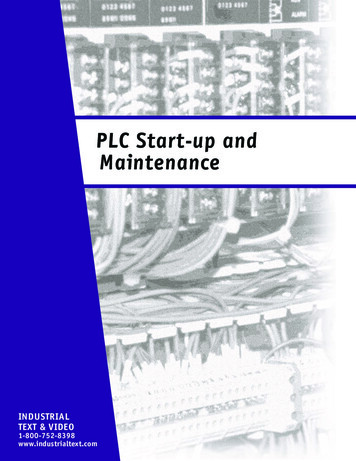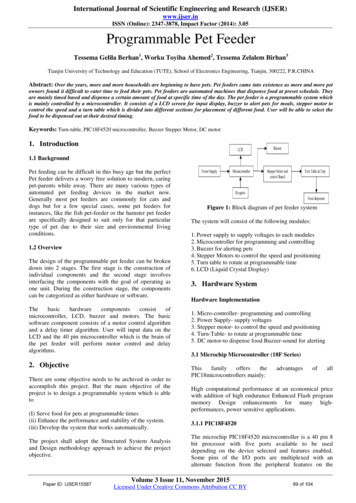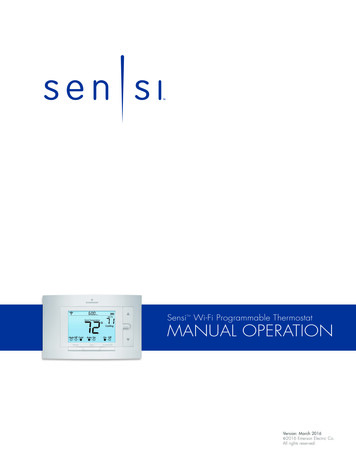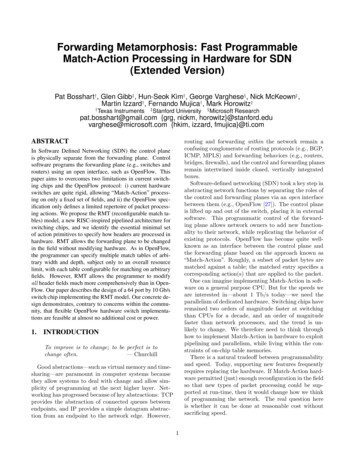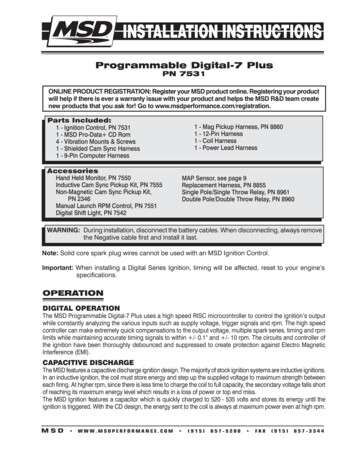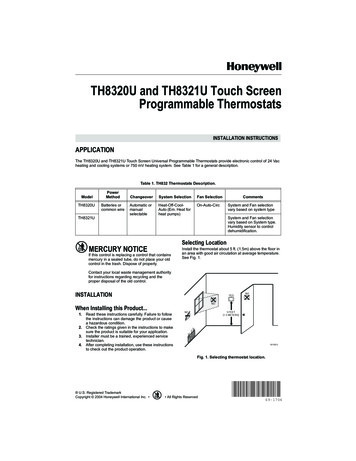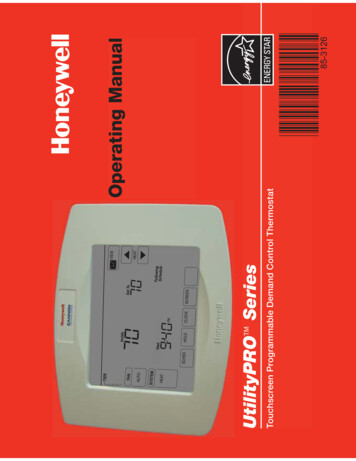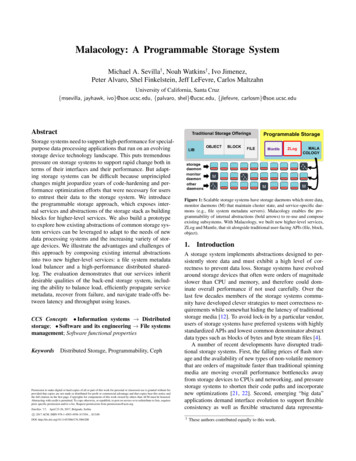
Transcription
Malacology: A Programmable Storage SystemMichael A. Sevilla† , Noah Watkins† , Ivo Jimenez,Peter Alvaro, Shel Finkelstein, Jeff LeFevre, Carlos MaltzahnUniversity of California, Santa Cruz{msevilla, jayhawk, ivo}@soe.ucsc.edu, {palvaro, shel}@ucsc.edu, {jlefevre, carlosm}@soe.ucsc.eduAbstractStorage systems need to support high-performance for specialpurpose data processing applications that run on an evolvingstorage device technology landscape. This puts tremendouspressure on storage systems to support rapid change both interms of their interfaces and their performance. But adapting storage systems can be difficult because unprincipledchanges might jeopardize years of code-hardening and performance optimization efforts that were necessary for usersto entrust their data to the storage system. We introducethe programmable storage approach, which exposes internal services and abstractions of the storage stack as buildingblocks for higher-level services. We also build a prototypeto explore how existing abstractions of common storage system services can be leveraged to adapt to the needs of newdata processing systems and the increasing variety of storage devices. We illustrate the advantages and challenges ofthis approach by composing existing internal abstractionsinto two new higher-level services: a file system metadataload balancer and a high-performance distributed sharedlog. The evaluation demonstrates that our services inheritdesirable qualities of the back-end storage system, including the ability to balance load, efficiently propagate servicemetadata, recover from failure, and navigate trade-offs between latency and throughput using leases.CCS Concepts Information systems Distributedstorage; Software and its engineering File systemsmanagement; Software functional propertiesKeywords Distributed Storage, Programmability, CephPermission to make digital or hard copies of all or part of this work for personal or classroom use is granted without feeprovided that copies are not made or distributed for profit or commercial advantage and that copies bear this notice andthe full citation on the first page. Copyrights for components of this work owned by others than ACM must be honored.Abstracting with credit is permitted. To copy otherwise, or republish, to post on servers or to redistribute to lists, requiresprior specific permission and /or a fee. Request permissions from permissions@acm.org.EuroSys ’17,April 23-26, 2017, Belgrade, SerbiaFigure 1: Scalable storage systems have storage daemons which store data,monitor daemons (M) that maintain cluster state, and service-specific daemons (e.g., file system metadata servers). Malacology enables the programmability of internal abstractions (bold arrows) to re-use and composeexisting subsystems. With Malacology, we built new higher-level services,ZLog and Mantle, that sit alongside traditional user-facing APIs (file, block,object).1.IntroductionA storage system implements abstractions designed to persistently store data and must exhibit a high level of correctness to prevent data loss. Storage systems have evolvedaround storage devices that often were orders of magnitudeslower than CPU and memory, and therefore could dominate overall performance if not used carefully. Over thelast few decades members of the storage systems community have developed clever strategies to meet correctness requirements while somewhat hiding the latency of traditionalstorage media [12]. To avoid lock-in by a particular vendor,users of storage systems have preferred systems with highlystandardized APIs and lowest common denominator abstractdata types such as blocks of bytes and byte stream files [4].A number of recent developments have disrupted traditional storage systems. First, the falling prices of flash storage and the availability of new types of non-volatile memorythat are orders of magnitude faster than traditional spinningmedia are moving overall performance bottlenecks awayfrom storage devices to CPUs and networking, and pressurestorage systems to shorten their code paths and incorporatenew optimizations [21, 22]. Second, emerging “big data”applications demand interface evolution to support flexibleconsistency as well as flexible structured data representa-c 2017 ACM. ISBN 978-1-4503-4938-3/17/04. . . 15.00DOI: http://dx.doi.org/10.1145/3064176.3064208†These authors contributed equally to this work.
tions. [3]. Finally, production-quality scalable storage systems available as open source software have established andare continuing to establish new, de-facto API standards at afaster pace than traditional standards bodies [31, 40].The evolutionary pressure placed on storage systems bythese trends raises the question of whether there are principles that storage systems designers can follow to evolve storage systems efficiently, without jeopardizing years of codehardening and performance optimization efforts. In this paper we investigate an approach that focuses on identifyingand exposing existing storage system resources, services,and abstractions that in a generalized form can be used toprogram new services. This ‘dirty-slate’ approach of factoring out useful code lets programmers re-use subsystems ofthe back-end storage system, thus inheriting their optimizations, established correctness, robustness, and efficiency.‘Clean-slate’ approaches could be implemented faster butthey do so at the expense of “throwing away” proven code.Contribution 1: We define a programmable storage system to be a storage system that facilitates the re-use and extension of existing storage abstractions provided by the underlying software stack, to enable the creation of new services via composition. A programmable storage system canbe realized by exposing existing functionality (such as filesystem and cluster metadata services and synchronizationand monitoring capabilities) as interfaces that can be “gluedtogether” in a variety of ways using a high-level language.Programmable storage differs from active storage [35]—theinjection and execution of code within a storage system orstorage device—in that the former is applicable to any component of the storage system, while the latter focuses at thedata access level. Given this contrast, we can say that activestorage is an example of how one internal component (thestorage layer) is exposed in a programmable storage system.To illustrate the benefits and challenges of this approachwe have designed and evaluated Malacology, a programmablestorage system that facilitates the construction of new services by re-purposing existing subsystem abstractions of thestorage stack. We build Malacology in Ceph, a popular opensource software storage stack. We choose Ceph to demonstrate the concept of programmable storage because it offersa broad spectrum of existing services, including distributedlocking and caching services provided by file system metadata servers, durability and object interfaces provided by theback-end object store, and propagation of consistent cluster state provided by the monitoring service (see Figure 1).Malacology is expressive enough to provide the functionality necessary for implementing new services.Malacology includes a set of interfaces that can be used asbuilding blocks for constructing novel storage abstractions,including:1. An interface for managing strongly-consistent timevarying service metadata.2. An interface for installing and evolving domain-specific,cluster-wide data I/O functionality.3. An interface for managing access to shared resourcesusing a variety of optimization strategies.4. An interface for load balancing resources across thecluster.5. An interface for durability that persists policies using theunderlying storage stack’s object store.Contribution 2: We implement two distributed servicesusing Malacology to demonstrate the feasibility of the programmable storage approach:1. A high-performance distributed shared log service calledZLog, that is an implementation of CORFU [6]2. An implementation of Mantle, the programmable loadbalancing service [37]The remainder of this paper is structured as follows. First,we describe and motivate the need for programmable storageby describing current practices in the open source softwarecommunity. Next we describe Malacology by presenting thesubsystems within the underlying storage system that were-purpose, and briefly describe how those system are usedwithin Malacology (Section 4). Then we describe the services that we have constructed in the Malacology framework(Section 5), and evaluate our ideas within our prototype implementation (Section 6). We conclude by discussing futureand related work.2.Application-Specific Storage StacksBuilding storage stacks from the ground up for a specific purpose results in the best performance. For example, GFS [18] and HDFS [38] were designed specificallyto serve MapReduce and Hadoop jobs, and use techniqueslike exposing data locality and relaxing POSIX constraintsto achieve application-specific I/O optimizations. Anotherexample is Boxwood [32], which experimented with B-treesand chunk stores as storage abstractions to simplify application building. Alternatively, general-purpose storage stacksare built with the flexibility to serve many applications byproviding standardized interfaces and tunable parameters.Unfortunately, managing competing forces in these systemsis difficult and users want more control from the generalpurpose storage stacks without going as far as building theirstorage system from the ground up.To demonstrate a recent trend towards more applicationspecific storage systems we examine the state of programmability in Ceph. Something of a storage Swiss army knife,Ceph simultaneously supports file, block, and object interfaces on a single cluster [1]. Ceph’s Reliable AutonomousDistributed Object Storage (RADOS) system is a cluster ofobject storage daemons that provide Ceph with data durability and integrity using replication, erasure-coding, and
scrubbing [50]. Ceph already provides some degree of programmability; the object storage daemons support domainspecific code that can manipulate objects on the server thathas the data local. These “interfaces” are implemented bycomposing existing low-level storage abstractions that execute atomically. They are written in C and are staticallyloaded into the system.The Ceph community provides empirical evidence thatdevelopers are already beginning to embrace programmablestorage. Figure 2 shows a dramatic growth in the production use of domain-specific interfaces in the Ceph community since 2010. In that figure, classes are functional groupings of methods on storage objects (e.g. remotely computingand caching the checksum of an object extent). What is mostremarkable is that this trend contradicts the notion that APIchanges are a burden for users. Rather it appears that gapsin existing interfaces are being addressed through ad-hoc approaches to programmability. In fact, Table 1 categorizes existing interfaces and we clearly see a trend towards reusableservices.programmers wanting to exploit application-specific semantics, and/or programmers knowing how to manage resourcesto improve performance. A solution based on applicationspecific object interfaces is a way to work around the traditionally rigid storage APIs because custom object interfacesgive programmers the ability to tell the storage system abouttheir application: if the application is CPU or I/O bound, if ithas locality, if its size has the potential to overload a singlenode, etc. Programmers often know what the problem is andhow to solve it, but until the ability to modify object interfaces, they had no way to express to the storage system howto handle their data.Our approach is to expose more of the commonly used,code-hardened subsystems of the underlying storage systemas interfaces. The intent is that these interfaces, which canbe as simple as a redirection to the persistent data store oras complicated as a strongly consistent directory service,should be used and re-used in many contexts to implementa wide range of services. By making programmability a‘feature’, rather than a ‘hack’ or ‘workaround’, we helpstandardize a development process that now is largely adhoc.3.ChallengesImplementing the infrastructure for programmability intoexisting services and abstractions of distributed storage systems is challenging, even if one assumes that the source codeof the storage system and the necessary expertise for understanding it is available. Some challenges include: Storage systems are generally required to be highly availFigure 2: [source] Since 2010, the growth in the number of co-designedobject storage interfaces in Ceph has been accelerating. This plot is thenumber of object classes (a group of interfaces), and the total number ofmethods (the actual API ngOtherExampleGeographically distribute replicasSnapshots in the block device ORScan extents for file system repairGrants clients exclusive accessGarbage collection, reference counting#117464Table 1: A variety of object storage classes exist to expose interfaces toapplications. # is the number of methods that implement these categories.The takeaway from Figure 2 is that programmers are already trying to use programmability because their needs,whether they be related to performance, availability, consistency, convenience, etc., are not satisfied by the existing default set of interfaces. The popularity of the custom object interface facility of Ceph could be due to a number of reasons,such as the default algorithms/tunables of the storage systembeing insufficient for the application’s performance goals,able so that any complete restarts of the storage system toreprogram them is usually unacceptable. Policies and optimizations are usually hard-wired intothe services and one has to be careful when factoringthem to avoid introducing additional bugs. These policies
storage stack. We build Malacology in Ceph, a popular open source software storage stack. We choose Ceph to demon-strate the concept of programmable storage because it offers a broad spectrum of existing services, including distributed locking and caching services provided byfile systemmeta-data servers, durability and object interfaces provided by the
